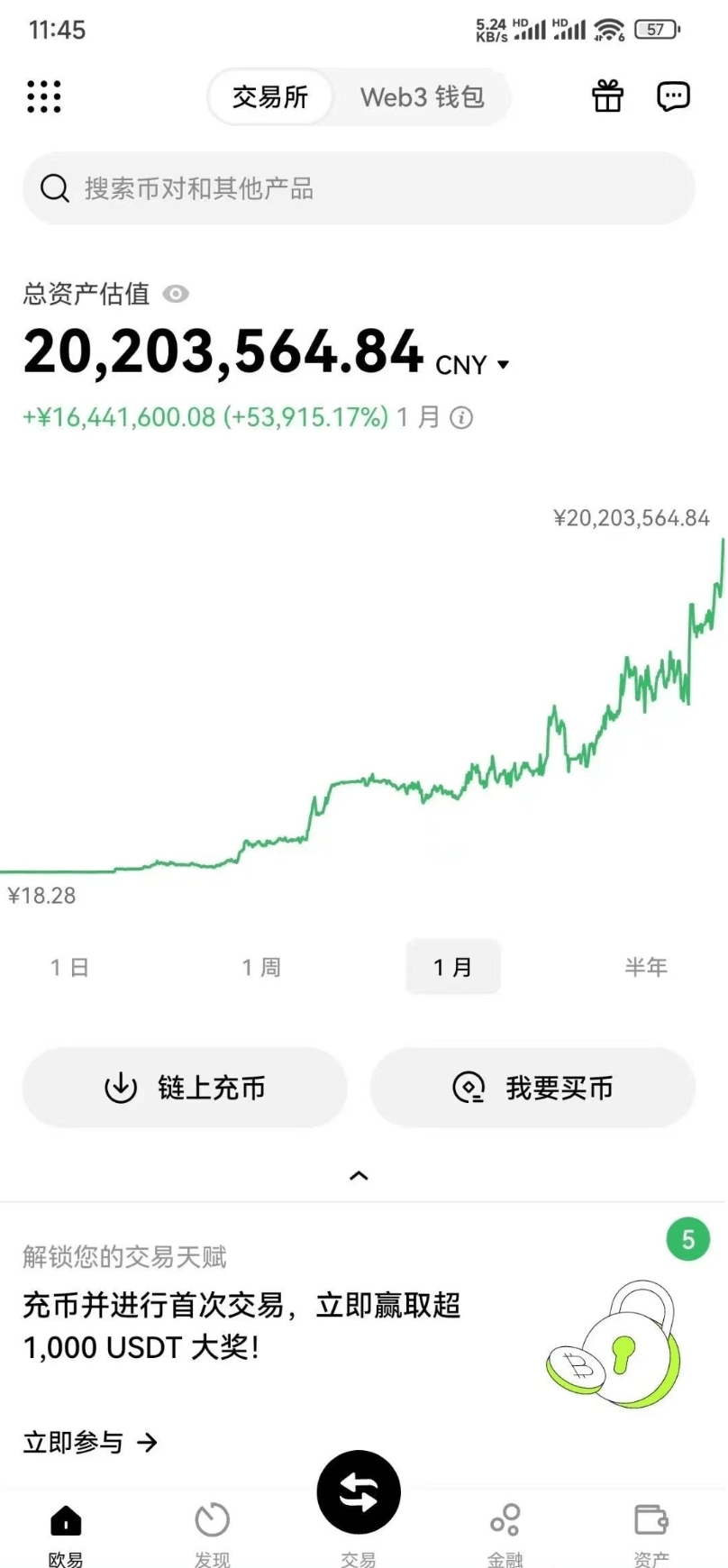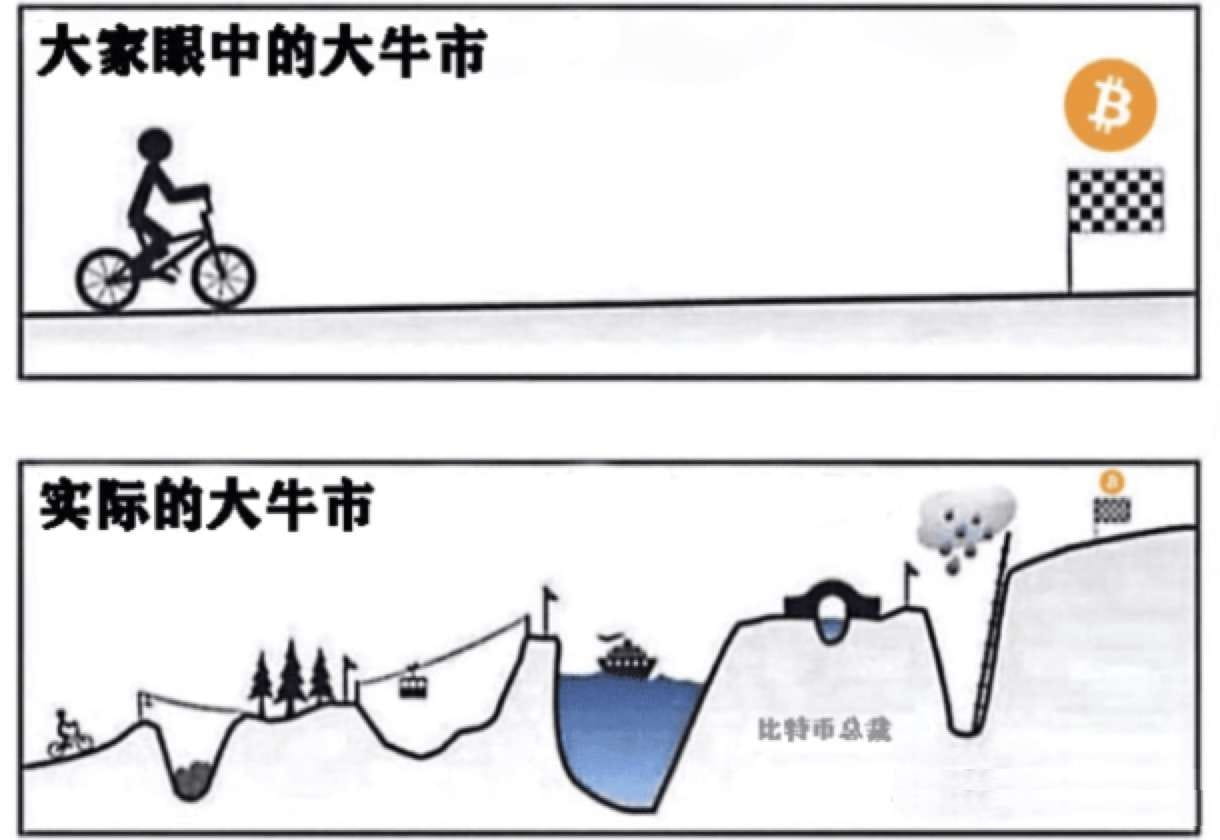From a loss of 800,000 to a profit of 50 million: The anti-human nature principle of trading.
Ten years of trading, six years full-time. I learned to tame greed and fear, from huge losses to stable profits. Now I can take care of my family while my account steadily grows. Trading doesn't rely on luck; it relies on understanding and execution.
First understand MACD: The "thermometer" of trends.
MACD is a moving average temperature difference meter: blue line (short term), yellow line (long term), histogram (difference), zero axis separates long and short (above is long, below is short).
- Golden Cross and Death Cross depend on position: a golden cross above zero is strong, a death cross below zero is harsh;
- Divergence is an alarm: when the price hits a new high and the indicator drops (top divergence), sell; when the price hits a new low and the indicator rises (bottom divergence), buy.
Remember: it lags behind, don't seek perfect entry and exit points; use it in conjunction with other indicators.
11 Bloody Disciplines
1. Don't act during sideways movement, guessing blindly will lose you money;
2. Popular coins should be exited within 3 days; don't fall in love with them;
3. Dare to hold strong trends; don't be scared away by fear of heights.
4. When there's a large green candle at a high position, sell half first;
5. The 20-day line is a safety belt; buy above the line and sell below it;
6. Don't sell when the price rises, don't buy when it plummets, and don't act during sideways movement;
7. Diversify positions, with a single coin not exceeding 10% position size;
8. Look at the capital flow for positive and negative news; don't trust the news.
9. Three indicators are required: MACD, Bollinger Bands, and trading volume;
10. Write a plan for each trade (what to buy, position size, stop loss, take profit);
11. Stop loss and take profit are lifelines; cut losses at 3%-5% and sell half after a rise.
Trading relies on discipline; following the rules allows you to survive. The market is not short of opportunities; what is lacking is the ability to survive until the opportunity comes. Stick to these, and you can also make profits.

Contract trading's three survival rules: rely on discipline, not luck.
First Tip: Don't bet on the direction; treat trading as a probability game.
Common Mistake for Beginners: Guessing rises and falls based on feelings, like a gambler throwing dice.
Expert Mindset:
Trend Judgment: First look at whether the market is rising or falling, then decide whether to go long or short.
Leverage Risk: 10x leverage earns 10% on a 1% rise, and a 1% drop leads to immediate liquidation.
Three Questions Before Placing an Order:
What is the current trend?
Are there any unexpected news?
Where to set the stop loss?
Best Entry Point: Wait for 'breakout + pullback confirmation' before taking action; it's better to earn less than to lose money!
Second Tip: Make money with strategies, don't rely on guesswork.
3 strategies suitable for beginners to make money:
① Grid Quantification — The ATM of volatile markets.
Applicable Scenario: BTC Sideways (e.g., 60k-65k range).
Operation: Place an order every 500 USDT, automatically buy low and sell high.
Returns: 3x leverage + small position size, individual profit of 15%, daily profit of 2%-5%.
② Funding Fee Arbitrage — Free Income
Method: Go long on spot + go short on contracts, locking in the funding rate difference.
Case Study: Funding fee 18%, spot annualized 2%, net profit 16% (earning 16,000 USDT a year on a 100,000 USDT investment).
③ Double opening hedge — insurance before major events.
Operation: Simultaneously open equal-value long and short positions, then stop loss on one side once the direction is clear, amplifying the other side.
Core: Don't predict rises and falls, just capture explosive market movements.
Third Tip: The only secret to not getting liquidated — risk management first!
99% of those who get liquidated die due to lack of discipline.
Position Management:
Start with a 1% position size; only increase the position after making a profit, with a single trade not exceeding 3%.
Immediately reduce positions when losing; if you lose three times consecutively, go to cash.
Iron Rules of Stop Loss:
Always set a stop loss (2%-3%) when placing an order; don't fantasize about miracles.
Once profits exceed 5%, move the stop loss to the breakeven point to ensure no loss.
Emotional Control:
Three consecutive losses? Mandatory rest for 24 hours!
Record the emotions and reasons for each trade, turning subjectivity into objectivity.
Capital Safety:
Strictly separate trading accounts from living expenses, leaving at least 1 year of backup funds.
Never use your living expenses to trade contracts!
Final Advice
Contract trading is about discipline, not luck.
The more you want to make quick money, the faster you die; the more you follow the rules, the longer you live.

The riskiest method should also be divided into three parts. In other words, you should at least give yourself three chances.
For example, if your total account balance is 200,000, and the maximum loss permitted by the client is 20%, which is 40,000, then I suggest your most aggressive loss plan is: the first time 10,000, the second time 10,000, the third time 20,000. I believe such a loss plan still has certain rationality. Because if you get one of the three correct, you can profit or at least continue to survive in the market. Not being kicked out of the market is itself a form of success, giving you a chance to win.
2. Grasp the overall market trend. Trends are much harder to trade than sideways movements because trends involve chasing highs and cutting losses, requiring patience with positions, while high selling and low buying align with human nature. The more it fits human nature, the less money can be made. It is precisely because it is difficult to trade that it becomes profitable. In an upward trend, any violent pullback should be an opportunity to go long. Remember the probabilities I mentioned? Therefore, if you're not in the market or have exited, patiently wait for a 10-20% drop, and boldly go long.
3. Set specific take profit and stop loss targets. Take profit and stop loss can be said to be the key to whether one can profit. In several trades, we need to ensure that total profit is greater than total loss. Achieving this is not difficult; just follow these points: ① Each stop loss ≤ 5% of total funds; ② Each profit > 5% of total funds; ③ Total trading win rate > 50%. Meeting the above requirements (profit-loss ratio greater than 1 and win rate greater than 50%) can lead to profitability. Of course, you can also have a high profit-loss ratio and low win rate or a low profit-loss ratio and high win rate. Anyway, as long as you ensure total profit is positive, total profit = initial capital × (average profit × win rate - average loss × loss rate).
4. Remember that excessive trading is risky. Since BTC perpetual contracts trade 24/7, many beginners operate every day, almost every trading day of the month. As the saying goes: 'If you walk by the river often, how can you avoid getting your shoes wet?' The more you trade, the more likely you are to make mistakes. After making mistakes, your mindset will deteriorate. Once your mindset changes for the worse, you might act impulsively and choose 'revenge' trading: possibly going against the trend and over-leveraging. This can lead to a series of mistakes, easily causing significant losses that may take years to recover.
Points to note when rolling positions:
1. Enough patience; the profits from rolling positions can be huge. As long as you can roll successfully a few times, you can earn at least a million or more. So, you can't roll easily; you need to find high-certainty opportunities.
2. High certainty opportunities refer to sideways fluctuations after a sharp decline, then breaking upward; at this time, the probability of following the trend is high, and you should get on board at the point of trend reversal.
3. Only go long, do not short.
Top 10 truths of the crypto world revealed, awakening you instantly and overturning your understanding.
Top 10 truths of the crypto world revealed, awakening you instantly and overturning your understanding!
1. You might think a certain altcoin could rise 100 times, but in reality, there is a 99.99% chance it will eventually go to zero.
2. When something is advertised as a money-making opportunity, it is likely time to exit.
3. When you feel the market is about to collapse and all coins will go to zero, it often means a bull market is about to arrive.
4. When you become increasingly certain about a certain coin's upward trend, it is likely that the whales are closing their positions.
5. Although you think making money in the crypto space is easy, in reality, losses are more likely to occur.
6. Don't overly believe that KOLs (Key Opinion Leaders) make a lot of money; some KOLs may earn less than you.
7. You might think the success rate of trading contracts is 50%, but in reality, the success rate for making money is less than 10%.
8. The whales are not your enemies; holding onto the whales tightly can lead to profits.
9. In the crypto space, no coin has real value; the only thing that creates value is human greed.
10. Getting rich in the crypto space often relies on luck, combined with some effort.
Too many people think they have the right understanding, and then rush in without considering the risks, only to have the market teach them a lesson!
It's hard to hear, but these are my valuable experiences from the past few years!
Principal first, risk second, profit third!
Patience, thoughtfulness, execution ability, and discipline — all will become essential secrets on your path to success!

What should you pay special attention to in the crypto space?
In this vast ocean of virtual currencies, I am also a seasoned sailor who has weathered storms. From being cautious at first to being proficient now, every step is filled with challenges and rewards. Today, I am willing to share my trading insights and practical experiences, hoping to light a lamp for those still exploring in the sea of cryptocurrencies.
Most people just entering the crypto space are in the secondary market, and the two major ways to play in the secondary market require a deep understanding: spot + contracts. Note: Only open large positions on BTC or ETH.
If you have a small amount of capital, or if the amount is insignificant to you when lost, for example, 10,000, which converts to about 1500 USDT, it is recommended to take out 100 USDT first and place it into the contract account. Then, open positions only with 10%, using 50-100x leverage, one by one. If you have no understanding of trading, you can first use this 100 USDT based on your feelings, whether you lose or earn depends on luck; this 100 USDT is just to let you experience how worthless money can be. Once you lose this 100 USDT, you need to start learning technical analysis+.
Any technical analysis method can be used, or any indicator, even naked candlestick charts are fine. While learning, observe the success rate of the techniques on the historical candlestick charts of the assets you trade. When you feel you have a further understanding of candlesticks and indicators, reinvest 100 USDT, using your learning outcomes to guide your trading. At this point, you may still experience both losses and gains. In most cases, you may not be able to strictly execute the learned content. Regardless, you will soon lose that 100 USDT, and then you need to start learning trading psychology.
You need to refine your execution based on trading psychology, even through indicators and technical analysis to gauge market sentiment.
If your learning ability is sufficient and your execution is strong enough, you can now strictly implement the technical analysis methods you have learned.
Re-inject 100 USDT, at this time your winning odds greatly increase, but after a while, you still successfully lost this 100 USDT.
Next, you should learn some mathematical knowledge.
The biggest difference between trading and gambling is that the win rate and profit-loss ratio can be changed through subjective initiative.
Learning technical skills, psychological analysis, and improving execution ability can increase your win rate, but the profit-loss ratio is the secret to making big money in contracts.
For example, if the lowest price on the Ethereum hourly chart is 1300 in the last 3 days, and the price repeatedly retraces to this level before bouncing back, you seize the opportunity to reduce your position at a price of 1302, with a stop loss at 1295. The historical highest rebound price is 1389. If the market goes in the right direction, it could even break through the resistance level and surge to 1400+. At this point, your potential risk-reward ratio exceeds 1:10, which is definitely a risk worth taking.
The premise of capturing the risk-reward ratio is to strictly execute the stop-loss strategy.
Contracts are the best test of human nature and endurance.
Spot trading with too little capital; if you invest 10,000, even if a bull market comes and your investment multiplies by 10, how much do you actually earn if you only capture 7 times?
It's not worth your effort at all. If time is limited, just buy Bitcoin or Ethereum near the bottom of the market. However, how many players in the crypto space are looking to make small profits?
In the investment process, reasonable position building is the basis for reducing costs and amplifying profits. How to build positions reasonably? What are the techniques for building positions?
Batch buying is an unbreakable principle. When it comes to building positions, investor friends often overlook one principle: batch buying. They always think that having little capital makes it simpler and more convenient to buy all at once, and of course, selling is also done all at once. Generally, such operations have hard flaws; once the decision is made, there is no room for recovery.
If building a position in batches, it is likely to accumulate at a lower price, diluting the cost while capturing good 'prey'. Similarly, the same logic applies to reducing positions in batches, allowing you to control risks while ensuring substantial returns. Overall, batch buying or reducing is based on a stable market trend, excluding sudden events like sharp rises, falls, or flash crashes.

Benefits of Holding:
1. Avoid misjudgments caused by 'false shorts' and 'false longs';
2. While controlling risks, reduce position building costs;
3. While controlling risks, ensure investment returns.
Of course, 'batching' also has its applicable scope.
Batch buying or reducing is based on a stable market trend, excluding sudden situations like sharp rises, falls, or flash crashes.